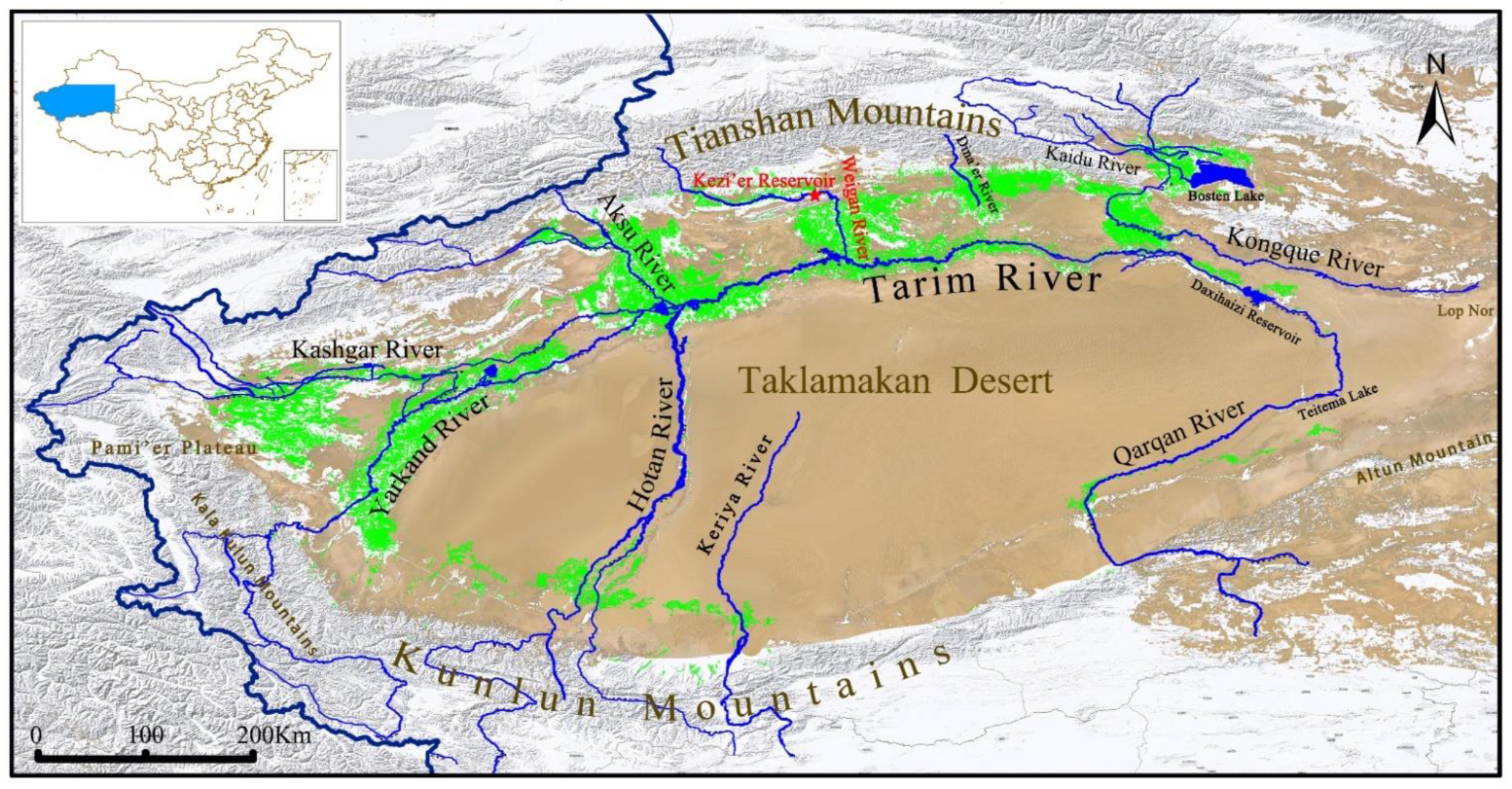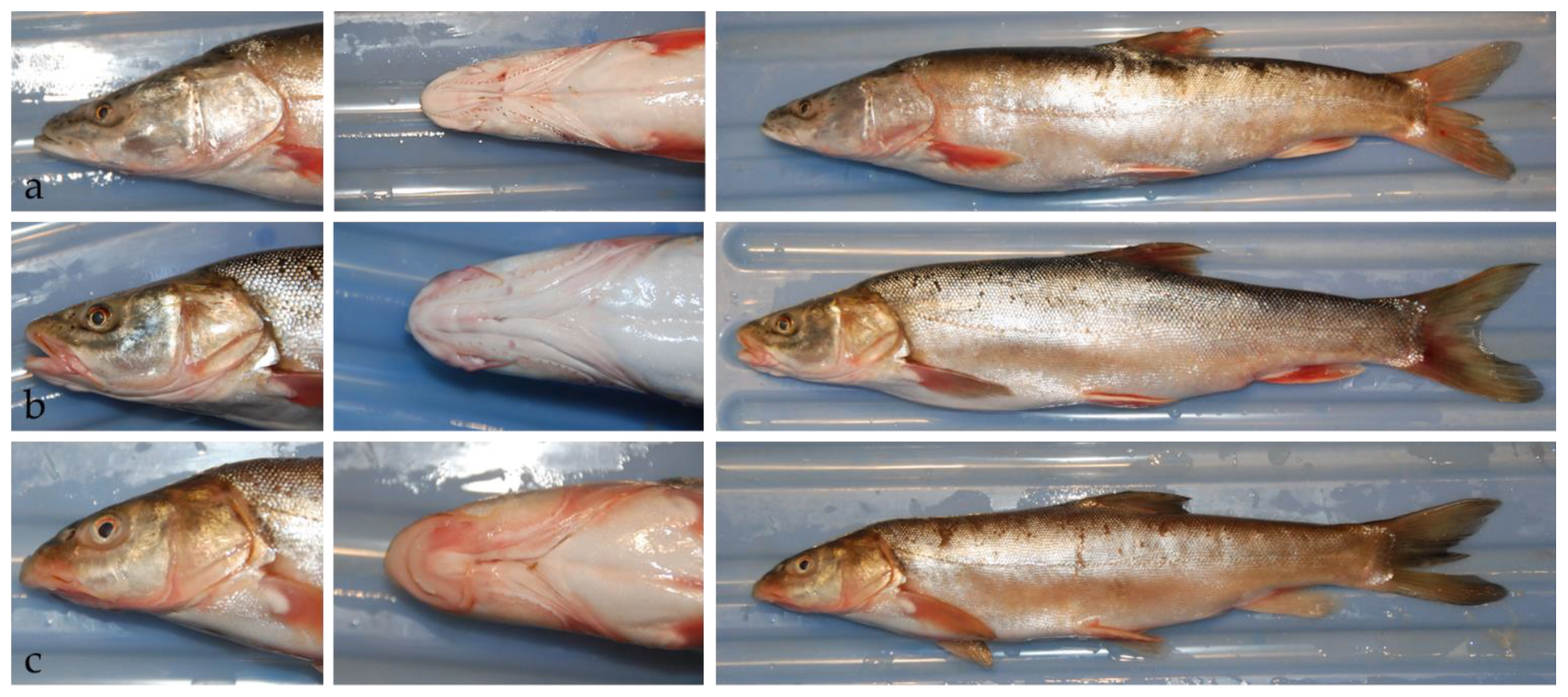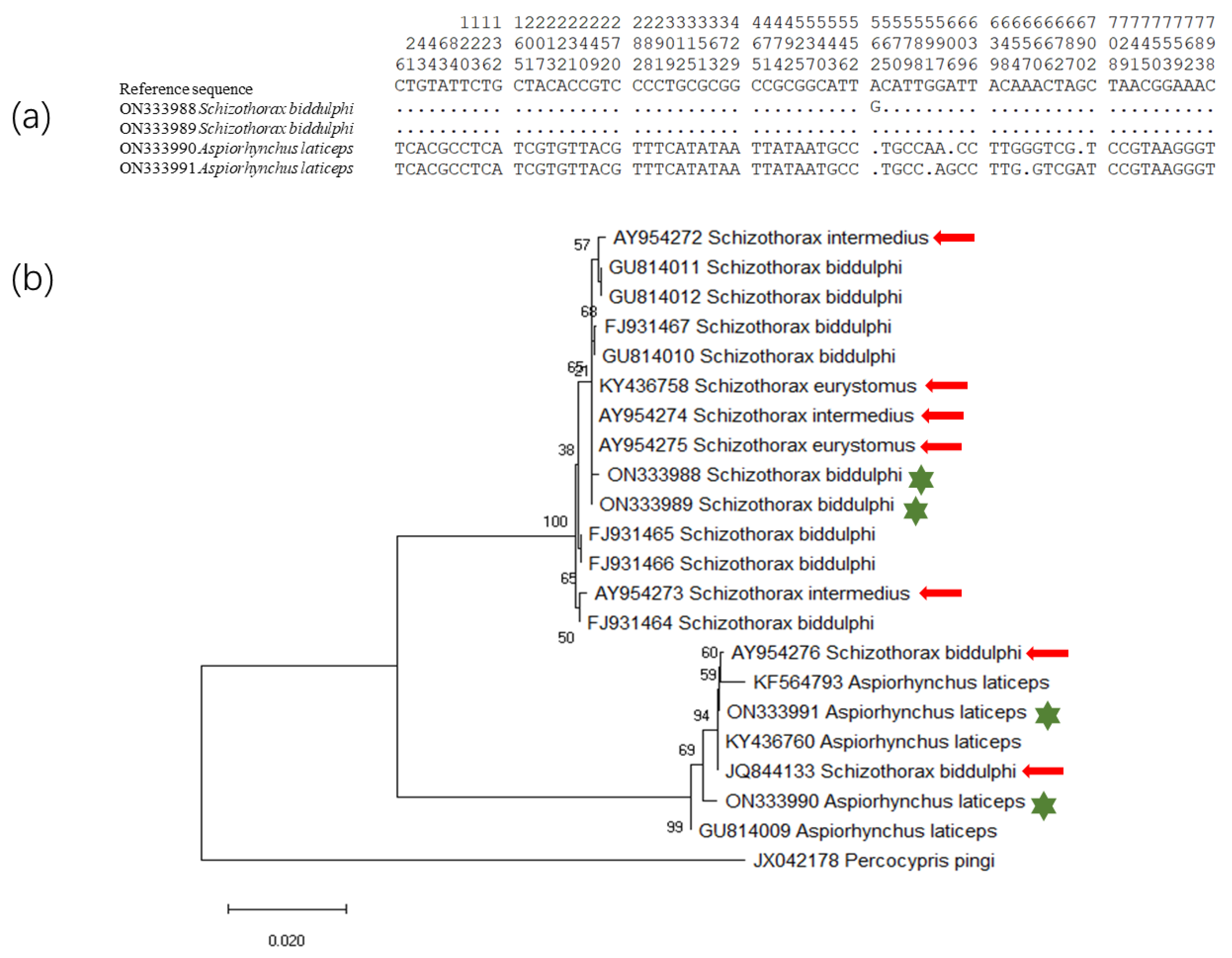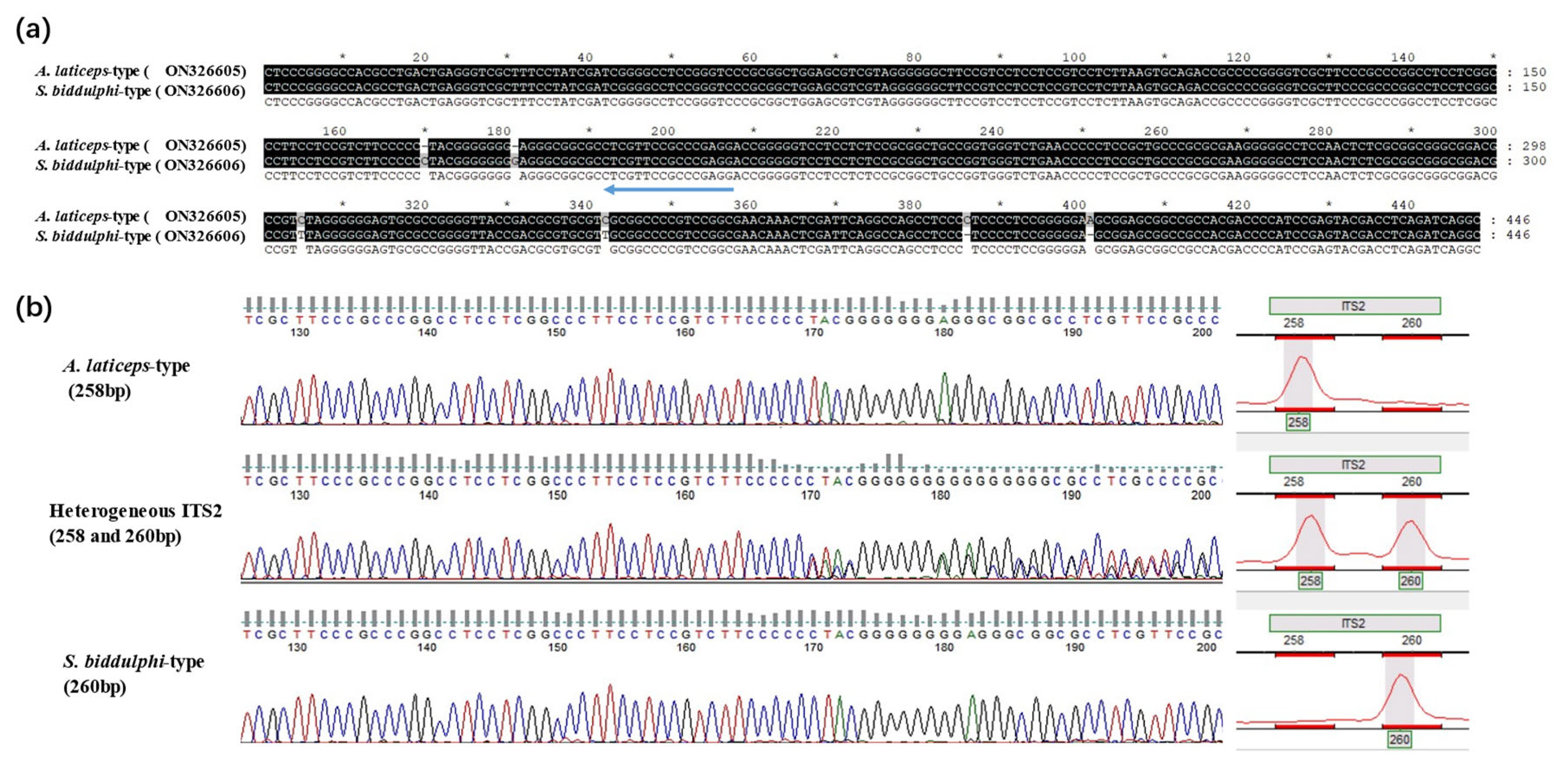Endangered Schizothoracin Fish in the Tarim River Basin Are Threatened by Introgressive Hybridization
Abstract
:Simple Summary
Abstract
1. Introduction
2. Materials and Methods
2.1. Sample Collection
2.2. Amplification and Analysis of cytb Gene
2.3. Amplification and Analysis of ITS2 Region
3. Results
3.1. Sequence Variation of cytb Gene
3.2. Sequence Features of ITS2 Region
3.3. Comparative Analysis of Morphological, Mitochondrial and Nuclear Data
4. Discussion
5. Conclusions
Author Contributions
Funding
Institutional Review Board Statement
Informed Consent Statement
Data Availability Statement
Acknowledgments
Conflicts of Interest
References
- Mallet, J. Hybridization as an invasion of the genome. Trends Ecol. Evol. 2005, 20, 229–237. [Google Scholar] [CrossRef] [PubMed]
- Mallet, J. Hybrid speciation. Nature 2007, 446, 279–283. [Google Scholar] [CrossRef] [PubMed]
- Soltis, P.S.; Soltis, D.E. The role of hybridization in plant speciation. Annu. Rev. Plant Biol. 2009, 60, 561–588. [Google Scholar] [CrossRef] [PubMed] [Green Version]
- Todesco, M.; Pascual, M.A.; Owens, G.L.; Ostevik, K.L.; Moyers, B.T.; Hübner, S.; Heredia, S.M.; Hahn, M.A.; Caseys, C.; Bock, D.G.; et al. Hybridization and extinction. Evol. Appl. 2016, 9, 892–908. [Google Scholar] [CrossRef]
- Ottenburghs, J. The genic view of hybridization in the anthropocene. Evol. Appl. 2021, 14, 2342–2360. [Google Scholar] [CrossRef]
- Levin, D.A.; Francisco-Ortega, J.; Jansen, R.K. Hybridization and the extinction of rare plant species. Conserv. Biol. 1996, 10, 10–16. [Google Scholar] [CrossRef]
- Wolf, D.E.; Takebayashi, N.; Rieseberg, L.H. Predicting the Risk of Extinction through Hybridization. Conserv. Biol. 2001, 15, 1039–1053. [Google Scholar] [CrossRef]
- Scribner, K.; Page, K.; Bartron, M. Hybridization in freshwater fishes: A review of case studies and cytonuclear methods of biological inference. Rev. Fish Biol. Fish. 2000, 10, 293–323. [Google Scholar] [CrossRef]
- Wallis, G.P.; Cameron-Christie, S.R.; Kennedy, H.L.; Palmer, G.; Sanders, T.R.; Winter, D.J. Interspecific hybridization causes long-term phylogenetic discordance between nuclear and mitochondrial genomes in freshwater fishes. Mol. Ecol. 2017, 26, 3116–3127. [Google Scholar] [CrossRef] [Green Version]
- Hata, H.; Uemura, Y.; Ouchi, K.; Matsuba, H. Hybridization between an endangered freshwater fish and an introduced congeneric species and consequent genetic introgression. PLoS ONE 2019, 14, e0212452. [Google Scholar] [CrossRef]
- Zolotova, A.O.; Nikitin, V.D.; Dzen, G.N. Identification of Hybrids between the Far Eastern Redfins Tribolodon hakonensis and T. brandtii Based on the Cephalic Lateral-Line System and Four Molecular Genetic Markers. J. Ichthyol. 2019, 59, 317–326. [Google Scholar] [CrossRef]
- Chen, Y.; Cao, W. Schizothoracinae. In Fauna Sinica Osteichthyes: Cypriniformes (II); Science Press: Beijing, China, 2000; pp. 273–390. (In Chinese) [Google Scholar]
- Guo, Y.; Zhang, R.; Cai, L. Fishes of Xinjiang; Xinjiang Science and Technology Press: Urumqi, China, 2012. (In Chinese) [Google Scholar]
- Cao, G. Rediscovery of Big-head Schizothoracin in Xinjiang. Sci. Fish Farm. 1999, 1, 40. (In Chinese) [Google Scholar]
- Ren, B.; Ren, M.; Guo, Y.; Zhang, R.; Ma, Y.; Liu, Y.; Aizezi; Tuersun; Abudu. Studies on the biological characteristics of Aspiorhynchus laticeps (Day). Chin. J. Fish. 2006, 2, 9–22. (In Chinese) [Google Scholar]
- Ma, Y.; Zhang, R.; Li, H.; Tuersun; Guo, Y. Research of Habitat and Community Conservation Biology of Aspiorhynchus laticeps. J. Hydroecol. 2010, 31, 38–42. (In Chinese) [Google Scholar]
- Zhang, R.; Guo, Y.; Ma, Y.; Tuersun. A survey on the resource and distribution of Schizothorax biddulphi günther. Freshw. Fish. 2007, 6, 76–78. (In Chinese) [Google Scholar]
- Nie, Z.; Wei, J.; Cheng, Y. The Study on Schizothorax biddulphi Günther in Biology. J. Tarim Univ. 2010, 22, 113–116. (In Chinese) [Google Scholar]
- White, R.S.A.; McHugh, P.A.; McIntosh, A.R. Drought survival is a threshold function of habitat size and population density in a fish metapopulation. Glob. Change Biol. 2016, 22, 3341–3348. [Google Scholar] [CrossRef]
- Yan, X.; Yang, J.; Tang, W.; Wang, L.; Adalaiti, T. Genetic diversity of two cyprinid fishes: Schizothorax biddulphi and Diptychus maculates in Kezilesu River, Xinjiang Uygur Autonomous Region based on cyt b gene sequences variation. Chin. J. Zool. 2009, 44, 8–13. (In Chinese) [Google Scholar]
- Yang, T.; Meng, W.; Zhang, R.; Guo, Y.; Hai, S. Comparative Analysis of mtDNA Gene between Two Rare Schizothoracine Fishes. Chin. J. Zool. 2011, 46, 47–54. (In Chinese) [Google Scholar]
- Yang, T.; Zhang, R.; Guo, Y.; Meng, W.; Hai, S.; Ma, Y. Comparative Study on Partial Mitochondrial COI Gene of Aspiorhynchus laticeps and Schizothorax biddulphi. J. Hydroecology 2011, 32, 45–50. (In Chinese) [Google Scholar]
- Yang, T.; Meng, W.; Guo, Y.; Ma, Y. Morphological and COI Sequences Analysis of Two Schizothoracinae Fishes in Xinjiang. Chin. J. Fish. 2013, 26, 10–14. (In Chinese) [Google Scholar]
- Meng, W.; Guo, Y.; Hai, S.; Yang, T.; Ma, Y.; Xie, C. Genetic Structure and Diversity of Schizothorax Biddulphi Populations. Acta Hydrobiol. Sin. 2012, 36, 851–857. (In Chinese) [Google Scholar] [CrossRef]
- Ayelhan, H.; Guo, Y.; Meng, W.; Yang, T.; Ma, Y. Phylogeny and divergence time estimation of Schizothoracinae fishes in Xinjiang. Hereditas 2014, 36, 1013–1020. (In Chinese) [Google Scholar]
- Ayelhan, H.; Guo, Y.; Meng, W.; Yang, T.; Karjan, A. Genetic diversity and population differentiation of Schizothorax biddulphi based on mtDNA control region sequence. J. Fish Sci. China 2016, 23, 944–954. (In Chinese) [Google Scholar]
- Bernt, M.; Braband, A.; Schierwater, B.; Stadler, P.F. Genetic aspects of mitochondrial genome evolution. Mol. Phylogenet. Evol. 2013, 69, 328–338. [Google Scholar] [CrossRef] [Green Version]
- Zieliński, P.; Nadachowska-Brzyska, K.; Wielstra, B.; Szkotak, R.; Covaciu-Marcov, S.D.; Cogălniceanu, D.; Babik, W. No evidence for nuclear introgression despite complete mtDNA replacement in the Carpathian newt (Lissotriton montandoni). Mol Ecol. 2013, 22, 1884–1903. [Google Scholar] [CrossRef]
- Coleman, A.W. ITS2 is a double-edged tool for eukaryote evolutionary comparisons. Trends Genet. 2003, 19, 370–375. [Google Scholar] [CrossRef]
- Nei, M.; Rooney, A.P. Concerted and birth-and-death evolution of multigene families. Annu. Rev. Genet. 2005, 39, 121–152. [Google Scholar] [CrossRef] [Green Version]
- Coleman, A.W. Is there a molecular key to the level of “biological species” in eukaryotes? a DNA guide. Mol. Phylogenet. Evol. 2009, 50, 197–203. [Google Scholar] [CrossRef]
- Yao, H.; Song, J.; Liu, C.; Luo, K.; Han, J.; Li, Y.; Pang, X.; Xu, H.; Zhu, Y.; Xiao, P.; et al. Use of ITS2 region as the universal DNA barcode for plants and animals. PLoS ONE 2010, 5, e13102. [Google Scholar] [CrossRef] [Green Version]
- Wyatt, P.M.W.; Pitts, C.S.; Butlin, R.K. A molecular approach to detect hybridization between bream Abramis brama, roach Rutlius rutilus and rudd Scardinius erythrophthalmus. J. Fish Biol. 2006, 69, 52–71. [Google Scholar] [CrossRef]
- Hayden, B.; Pulcini, D.; Kelly-Quinn, M.; O’Grady, M.; Caffrey, J.; Mcgrath, A.; Mariani, S. Hybridisation between two cyprinid fishes in a novel habitat: Genetics, morphology and life-history traits. BMC Evol. Biol. 2010, 10, 169. [Google Scholar] [CrossRef] [PubMed] [Green Version]
- Xiao, W.; Zhang, Y.; Liu, H. Molecular systematics of Xenocyprinae (Teleostei: Cyprinidae): Taxonomy, biogeography, and coevolution of a special group restricted in East Asia. Mol. Phylogenet. Evol. 2001, 18, 163–173. [Google Scholar] [CrossRef] [PubMed] [Green Version]
- Thompson, J.D.; Gibson, T.J.; Plewniak, F.; Jeanmougin, F.; Higgins, D.G. The ClustalX windows interface: Flexible strategies for multiple sequence alignment aided by quality analysis tools. Nucleic Acids Res. 1997, 25, 4876–4882. [Google Scholar] [CrossRef] [PubMed] [Green Version]
- Julio, R.; Albert, F.M.; Juan, C.S.; Sara, G.R.; Pablo, L.; Sebastián, E.R.; Alejandro, S. DnaSP v6: DNA Sequence Polymorphism Analysis of Large Datasets. Mol. Biol. Evol. 2017, 34, 3299–3302. [Google Scholar]
- Kumar, S.; Stecher, G.; Li, M.; Knyaz, C.; Tamura, K. MEGA X: Molecular Evolutionary Genetics Analysis across computing platforms. Mol. Biol. Evol. 2018, 35, 1547–1549. [Google Scholar] [CrossRef]
- Brownstein, M.J.; Carpten, J.D.; Smith, J.R. Modulation of non-templated nucleotide addition by Taq DNA polymerase: Primer modifications that facilitate genotyping. BioTechniques 1996, 20, 1004–1006, 1008–1010. [Google Scholar] [CrossRef] [Green Version]
- Haysa, A.; Zhang, R.; Niu, J.; Hu, J.; Liu, H.; Zhang, Y.; Tursun, T.; Feng, Y. Relationship of Schizothorax Heckel in Tarim River basin based on COI gene. J. Fish. Sci. China 2021, 28, 1417–1425. (In Chinese) [Google Scholar]
- Kong, Z.; Deng, M.; Ling, H.; Wang, G.; Xu, S.; Wang, Z. Ecological security assessment and ecological restoration countermeasures in the dry-up area of the lower Tarim River. Arid. Zone Res. 2021, 38, 1128–1139. (In Chinese) [Google Scholar]
- Guo, Y.; Xie, C.; Luo, G.; Chen, S. Present situation and protection of aquatic germplasm resources in Xinjiang Uygur Autonomous Region. Fish. China 2021, 2021, 67–71. (In Chinese) [Google Scholar]
- Yang, Z.; Cao, X.; Wei, J.; Reng, Y.; Nie, Z. Morphological characteristics of Schizothorax biddulphi in Qarqan River of Xinjiang. Jiangsu Agric. Sci. 2019, 47, 188–190. (In Chinese) [Google Scholar]




| Primers | Sequence (5′-3′) | Reference |
|---|---|---|
| L14724 | GACTTGAAGAACCACCGTTG | [35] |
| H15915 | CTCCGATCTCCGGATTACAAGAC | [35] |
| 15353F | CGCTAACGAYGCACTAGTTGA | This study |
| ALCB_104F | GCCTTCTGGGATTATGCTTAGC | This study |
| ALCB_1005R | AGGATAACTATGTCTGCAACC | This study |
| ALCB_581R | CGGTTGCGTCGGCAATGACA | This study |
| ALCB_494F | GAGGCGGATTCTCGGTAGAT | This study |
| 5.8S_F | CAGGACACATTGATCATCGACAC | This study |
| 28S_R | CCGCTACTGAGGGAATCCTTGTT | This study |
| ITS2_239R | GTTTCCTCGAGCGGAACGAG | This study |
| n | h | Hd | π (%) | K | S | |
|---|---|---|---|---|---|---|
| Aspiorhynchus laticeps-type | 15 | 2 | 0.343 ± 0.128 | 0.172 ± 0.064 | 1.371 | 4 |
| Schizothorax biddulphi-type | 45 | 10 | 0.283 ± 0.068 | 0.035 ± 0.009 | 0.283 | 1 |
| Total | 69 | 4 | 0.533 ± 0.059 | 2.935 ± 0.477 | 23.425 | 70 |
| Taxon | ITS2 Genotype | A. laticeps Type (ON333990) | A. laticeps Type (ON333991) | S. biddulphi Type (ON333988) | S. biddulphi Type (ON333989) | Total |
|---|---|---|---|---|---|---|
| A. laticeps ( homogeneous ITS2) | 258 bp | 2 | 3 | 5 | ||
| S. esocinus (heterogeneous ITS2) | 258 bp and 260 bp | 3 | 1 | 4 | ||
| S. biddulphi (heterogeneous ITS2) | 258 bp and 260 bp | 1 | 5 | 1 | 4 | 11 |
| S. biddulphi (homogeneous ITS2) | 260 bp | 1 | 8 | 40 | 49 | |
| Total | 3 | 12 | 9 | 45 | 69 |
Publisher’s Note: MDPI stays neutral with regard to jurisdictional claims in published maps and institutional affiliations. |
© 2022 by the authors. Licensee MDPI, Basel, Switzerland. This article is an open access article distributed under the terms and conditions of the Creative Commons Attribution (CC BY) license (https://creativecommons.org/licenses/by/4.0/).
Share and Cite
Cheng, L.; Song, D.; Yu, X.; Du, X.; Huo, T. Endangered Schizothoracin Fish in the Tarim River Basin Are Threatened by Introgressive Hybridization. Biology 2022, 11, 981. https://doi.org/10.3390/biology11070981
Cheng L, Song D, Yu X, Du X, Huo T. Endangered Schizothoracin Fish in the Tarim River Basin Are Threatened by Introgressive Hybridization. Biology. 2022; 11(7):981. https://doi.org/10.3390/biology11070981
Chicago/Turabian StyleCheng, Lei, Dan Song, Xiaoli Yu, Xue Du, and Tangbin Huo. 2022. "Endangered Schizothoracin Fish in the Tarim River Basin Are Threatened by Introgressive Hybridization" Biology 11, no. 7: 981. https://doi.org/10.3390/biology11070981
APA StyleCheng, L., Song, D., Yu, X., Du, X., & Huo, T. (2022). Endangered Schizothoracin Fish in the Tarim River Basin Are Threatened by Introgressive Hybridization. Biology, 11(7), 981. https://doi.org/10.3390/biology11070981





